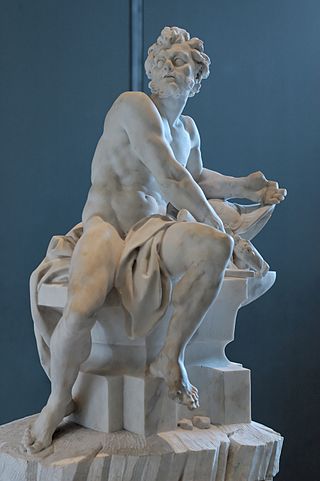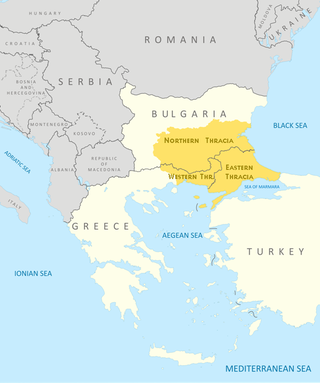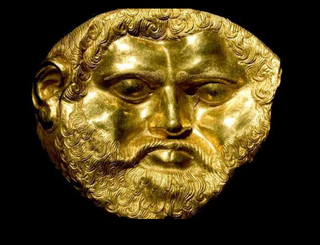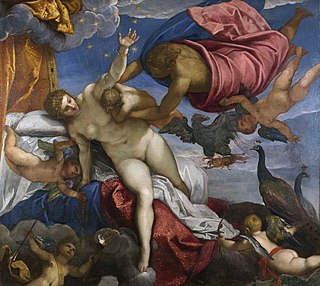Related Research Articles

Hephaestus is the Greek god of artisans, blacksmiths, carpenters, craftsmen, fire, metallurgy, metalworking, sculpture and volcanoes. Hephaestus's Roman counterpart is Vulcan. In Greek mythology, Hephaestus was either the son of Zeus and Hera or he was Hera's parthenogenous child. He was cast off Mount Olympus by his mother Hera because of his lameness, the result of a congenital impairment; or in another account, by Zeus for protecting Hera from his advances.

Thrace is a geographical and historical region in Southeast Europe. Bounded by the Balkan Mountains to the north, the Aegean Sea to the south, and the Black Sea to the east, it comprises present-day southeastern Bulgaria, northeastern Greece, and the European part of Turkey, roughly the Roman Province of Thrace. Lands also inhabited by ancient Thracians extended in the north to modern-day Northern Bulgaria and Romania and to the west into Macedonia.
In Greek mythology, Apate is the goddess and personification of deceit. Her mother is Nyx, the personification of the night. In Roman mythology her equivalent is Fraus (Fraud), while her male counterpart is Dolus (Deception), and her opposite number Aletheia, the goddess of truth.
Pawnee mythology is the body of oral history, cosmology, and myths of the Pawnee people concerning their gods and heroes. The Pawnee are a federally recognized tribe of Native Americans, originally located on the Great Plains along tributaries of the Missouri and Platte Rivers in Nebraska and Kansas and currently located in Oklahoma. They traditionally speak Pawnee, a Caddoan language. The Pawnees lived in villages of earth lodges. They grew corn and went on long bison hunts on the open plains twice a year. The tribe has four bands: the Skidi and "the South Bands" consisted of the Chawi, the Kitkahahki and the Pitahawirata Pawnee.

The Dacians were the ancient Indo-European inhabitants of the cultural region of Dacia, located in the area near the Carpathian Mountains and west of the Black Sea. They are often considered a subgroup of the Thracians. This area includes mainly the present-day countries of Romania and Moldova, as well as parts of Ukraine, Eastern Serbia, Northern Bulgaria, Slovakia, Hungary and Southern Poland. The Dacians and the related Getae spoke the Dacian language, which has a debated relationship with the neighbouring Thracian language and may be a subgroup of it. Dacians were somewhat culturally influenced by the neighbouring Scythians and by the Celtic invaders of the 4th century BC.

The Thracians were an Indo-European speaking people who inhabited large parts of Southeast Europe in ancient history. Thracians resided mainly in Southeast Europe in modern-day Bulgaria, Romania, and northern Greece, but also in north-western Anatolia in Turkey.

The Cicones or Ciconians were a Homeric Thracian tribe, whose stronghold in the time of Odysseus was the town of Ismara, located at the foot of mount Ismara, on the south coast of Thrace. They are mentioned in book two of the Iliad as having joined the war on the side of the Trojans, led by Euphemus. In book nine of Homer's Odyssey, Odysseus and his men take Ismara by surprise and slay most of the Ciconian men they come across, taking Ciconian women as slaves. Later Ciconian reinforcements arrive and attack the invading Achaeans, killing so many of them that Odysseus and his men are forced to flee in their ships. Six men of each of Odysseus' ships were killed:
When I had set sail thence the wind took me first to Ismarus, which is the city of the Cicons. There I sacked the town and put the people to the sword. We took their wives and also much booty which we divided equitably amongst us, so that none might have reason to complain. I then said that we had better make off at once, but my men very foolishly would not obey me, so they stayed there drinking much wine and killing great numbers of sheep and oxen on the sea shore. Meanwhile the Cicons cried out for help to other Cicons who lived inland. These were more in number, and stronger, and they were more skilled in the art of war, for they could fight, either from chariots or on foot as the occasion served; in the morning, therefore, they came as thick as leaves and bloom in summer, and the hand of heaven was against us, so that we were hard pressed. They set the battle in array near the ships, and the hosts aimed their bronze-shod spears at one another. So long as the day waxed and it was still morning, we held our own against them, though they were more in number than we; but as the sun went down, towards the time when men loose their oxen, the Cicons got the better of us, and we lost half a dozen men from every ship we had; so we got away with those that were left.

The Labours of Hercules or Labours of Heracles are a series of tasks carried out by Heracles, the greatest of the Greek heroes, whose name was later romanised as Hercules. They were accomplished in the service of King Eurystheus. The episodes were later connected by a continuous narrative.

Teres I was the first king of the Odrysian kingdom of Thrace. Thrace had nominally been part of the Persian empire since 516 BC during the rule of Darius the Great, and was re-subjugated by Mardonius in 492 BC.

The Bessi or Bessae were a Thracian tribe that inhabited the upper valley of the Hebros and the lands between the Haemus and Rhodope mountain ranges in historical Thrace.

The Thracian religion comprised the mythology, ritual practices and beliefs of the Thracians, a collection of closely related ancient Indo-European peoples who inhabited eastern and southeastern Europe and northwestern Anatolia throughout antiquity and who included the Thracians proper, the Getae, the Dacians, and the Bithynians. The Thracians themselves did not leave an extensive written corpus of their mythology and rituals, but information about their beliefs is nevertheless available through epigraphic and iconographic sources, as well as through ancient Greek writings.
Hercules and the Lost Kingdom is the second television movie in the syndicated fantasy series Hercules: The Legendary Journeys.

The Origin of the Milky Way is a painting by the Italian late Renaissance master Jacopo Tintoretto, in the National Gallery, London, formerly in the Orleans Collection. It is an oil painting on canvas, and dates from ca.1575–1580.
Cebrenii is a Thracian tribe. They are mentioned by Polyaenus and Strabo.
Sycaeboae is the name of a Thracian tribe, which was mentioned by Polyaenus.

The history of Thracian warfare spans from the 10th century BC up to the 1st century AD in the region defined by Ancient Greek and Latin historians as Thrace. It concerns the armed conflicts of the Thracian tribes and their kingdoms in the Balkans. Apart from conflicts between Thracians and neighboring nations and tribes, numerous wars were recorded among Thracian tribes.
References
- ↑ Polyaenus: Stratagems - BOOK 7 ,The generals of the Cebrenii and Sycaeboae, two Thracian tribes, were chosen from among the priests of Hera. Cosingas, according to the tradition of the country, was elected to be their priest and general; but the army took some objection to him, and refused to obey him. To suppress the rebelliousness that had taken hold of the troops, Cosingas built a number of long ladders, and fastened them one to another. He then put out a report, that he had decided to climb up to heaven, in order to inform Hera of the disobedience of the Thracians. The Thracians, who are notoriously stupid and ridiculous, were terrified by the idea of their general's intended journey, and the resulting wrath of heaven. They implored him not to carry out his plan, and they promised with an oath to obey all of his future commands